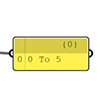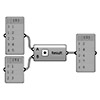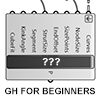In this short tutorial, I am showing the essentials of data domains in Grasshopper. A domain is a data type in Grasshopper that represents a portion of the 1d or 2d number space. This requires a starting and ending point in those spaces. In 1d, these points are two numbers. Then, the domain represents all the numbers between them. In 2d, a data domain is represented by two coordinates (u, […]
Posts with the keyword dataflow
Data structures and data matching principles are important to be able to design with #Grasshopper. In this tutorial, I show data matching procedures with arithmetic operations. Then I repeat them in the production of geometric objects. I think it should be easier to use this programming language once the students understand the basic principles. Therefore it would be easier to design with it. Sometimes the design process of these diagrams […]
We continue the Grasshopper for Beginners (2) series with the data flow programming concept. Control flow diagrams we use in traditional programming languages control the sequence of executed commands. In data flow diagrams, the focus is not on the order of commands but on how the data progresses. In the previous example, it doesn’t matter whether the Circle and Polyline command runs first. As a result, both are prerequisites for […]
This is a new series aimed at beginners in Grasshopper. The design method pioneered by Grasshopper with the way he defines geometric relationships is becoming increasingly popular today. Its interactive interface, which looks like a game or a puzzle at first glance may seem easy and its impressive geometric results are a little dazzling. But when you enter the world of Grasshopper, it is understood that it is not a […]
Design scripting is initially based on secondary syntactic mechanisms that control sequential executions of code. We call this model of computation control flow programming. On the other hand, dataflow represents a widespread alternative to control flow by utilizing concurrent streams of data. Dataflow programming languages are also considered as pedagogical tools in fields where the coders are not expert computer programmers. In the last decade, new parametric modeling tools introduced […]












